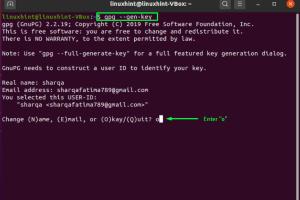Mastering GPG on Ubuntu: A Comprehensive Setup and Usage Guide

-
Quick Links:
- Introduction
- What is GPG?
- Why Use GPG for Ubuntu?
- Installing GPG on Ubuntu
- Configuring GPG
- Creating Your GPG Keys
- Using GPG
- Using GPG with Email
- Advanced Topics in GPG
- Case Studies and Real-World Usage
- Best Practices for GPG
- Troubleshooting Common Issues
- FAQs
- Conclusion
Introduction
In an era where digital security is paramount, mastering tools that offer encryption and privacy is essential. GNU Privacy Guard (GPG) is one such tool that enables users to encrypt and sign their data and communications. This article will guide you through the entire process of setting up and using GPG on Ubuntu, ensuring that you can communicate securely and maintain the privacy of your data.
What is GPG?
GNU Privacy Guard (GPG) is a free implementation of the OpenPGP standard. It allows you to encrypt files and emails, ensuring that only the intended recipient can read them. GPG provides a way to create public and private keys, which are fundamental to its encryption process.
GPG is widely used for securing communications and protecting sensitive information from unauthorized access. It is an open-source project, meaning anyone can contribute to its development and use it freely.
Why Use GPG for Ubuntu?
Using GPG on Ubuntu offers several advantages:
- Open-source: GPG is free to use and modify, making it accessible to everyone.
- Strong encryption: GPG uses robust encryption algorithms to secure your data.
- Widely supported: Many applications support GPG integration, enhancing its usability.
- Community-driven: Active development and a supportive community ensure that GPG remains secure and up-to-date.
Installing GPG on Ubuntu
Installing GPG on Ubuntu is a straightforward process. Here's how to do it:
Step 1: Update your package list
sudo apt updateStep 2: Install GPG
sudo apt install gnupgOnce installed, you can verify the installation by checking the version:
gpg --versionConfiguring GPG
After installation, you need to configure GPG to suit your needs:
Setting up your user ID
Your user ID will typically be your name and email address. You can configure it with:
gpg --full-generate-keyFollow the prompts to set up your key type, size, expiration, and user ID.
Creating Your GPG Keys
Creating GPG keys is an essential step in using GPG effectively:
Step 1: Generate a new key pair
Use the command:
gpg --gen-keyStep 2: Follow the prompts
Choose the default options unless you have specific requirements. After generation, your keys will be saved in your keyring.
Using GPG
Now that you have your keys, you can use GPG to encrypt and decrypt files:
Encrypting a file
To encrypt a file, use the command:
gpg -e -r [email protected] filename.txtDecrypting a file
To decrypt the file, use:
gpg -d filename.txt.gpgGPG will prompt you for your passphrase to complete the decryption.
Using GPG with Email
GPG can be integrated with email clients to secure your communications:
Step 1: Install an email client
Clients like Thunderbird support GPG through the Enigmail extension. Install Thunderbird with:
sudo apt install thunderbirdStep 2: Set up Enigmail
Follow the Enigmail setup wizard to integrate your GPG keys with your email account.
Advanced Topics in GPG
Once you are comfortable using GPG, explore advanced features like:
- Key Signing: Verifying the authenticity of keys.
- Key Management: Exporting and importing keys.
- Subkeys: Creating additional keys for different purposes.
Case Studies and Real-World Usage
Many organizations use GPG for secure communication. For instance, the Linux Foundation uses GPG for signing release packages, ensuring the integrity of their software. This practice highlights the importance of GPG in maintaining trust in software updates.
Best Practices for GPG
To maximize security, consider these best practices:
- Regularly update your GPG software.
- Backup your keys securely.
- Use strong passphrases.
Troubleshooting Common Issues
Here are some common issues you might encounter:
- Expired keys: Renew your keys with the appropriate commands.
- Key not found: Ensure your keyring is correctly configured.
FAQs
1. What is the difference between GPG and PGP?
GPG is an open-source implementation of the PGP standard, while PGP is a proprietary product.
2. Can I use GPG on Windows?
Yes, GPG is cross-platform and can be used on Windows and macOS as well.
3. Is GPG secure?
When used correctly, GPG is considered very secure, leveraging strong encryption algorithms.
4. How do I share my public key?
You can export your public key with the command gpg --export -a 'Your Name' > publickey.asc and share the file.
5. What if I lose my private key?
If you lose your private key, you will not be able to decrypt messages sent to you. Always backup your keys.
6. How do I revoke a key?
Use gpg --gen-revoke [email protected] to create a revocation certificate.
7. Can GPG encrypt folders?
Yes, you can create an archive of the folder and then encrypt it with GPG.
8. How do I export my private key?
Export your private key with gpg --export-secret-keys -a 'Your Name' > privatekey.asc.
9. What if my key gets compromised?
If you suspect your key has been compromised, revoke it immediately and generate a new key pair.
10. Can GPG be automated in scripts?
Yes, GPG commands can be integrated into scripts for automated encryption and decryption.
Conclusion
Setting up and using GPG on Ubuntu empowers you to secure your communications and protect sensitive data effectively. By following the steps outlined in this guide, you can master GPG and utilize it to enhance your digital security. Remember to stay updated with best practices and continuously educate yourself on new features and updates in the ever-evolving field of encryption.